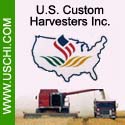 |
 |

|
|
|
New York Ag News Headlines |
 |
Ways Organic Fertilizer Improves Culinary Herb Production
J. Gimondo & C. Currey, MSU; K. Delate, Iowa State; & N. Mattson, Cornell - 11/28/2022
Culinary herbs are increasingly popular among consumers. As a result, commercial producers are increasingly growing containerized herbs. Additionally, since herbs are consumed, the value-added organic market poses additional opportunities for producers.
While there are a wide variety of organic fertilizers available, finding a fertilizer source that is consistent, uniform, and easy to incorporate into production makes producing an organic crop much easier. Suståne is an organic fertilizer utilizing turkey poultry litter with a 45-day release period available in fine- and medium-grade particle sizes with a guaranteed analysis providing all primary and secondary macronutrients and iron. Given the nutrient analysis, release period, and availability in a fine-grade particle size, Suståne is an excellent candidate for a slow-release fertilizer to incorporate into organic culinary herb production.
Our team of researchers recently designed a study to determine what concentrations of Suståne would be useful for growing organic herb seedling plugs.
To determine what organic turkey litter fertilizer concentrations were most appropriate for producing plugs, we selected six of the most popular culinary herbs for our study, including sweet basil (Ocimum basilicum 'Nufar'), purple basil (Ocimum basilicum 'Red Rubin'), common sage (Salvia officinalis), flat-leaf parsley (Petroselinum crispum 'Giant of Italy'), cilantro (Coriandrum sativum 'Leisure'), and dill (Anethum graveolens 'Hera'). All seeds were supplied from a commercial source and were certified organic for this study.
Prior to filling plug trays, the organic propagation substrate was amended with a fine-grade fertilizer (8N--4P--4K; Suståne) comprised of composted turkey litter, feather meal, and sulfate of potash at one of six different concentrations: 0, 4.2, 8.4, 12.6, 16.9, or 21.1 lbs. of fertilizer per cubic yard of substrate. While these concentrations may seem high compared to the concentrations of conventional or traditional controlled-release fertilizers commonly used in commercial production, it is important to note that the nitrogen concentration in the organic fertilizer we used is roughly 25% to 50% lower than many conventional controlled-release fertilizers.
The 128-cell plug trays were filled with substrate containing fertilizer and seeds were sown. Common sage, cilantro, dill, and parsley were lightly covered with coarse vermiculite, while the sweet and purple basil were left uncovered. Trays were watered-in with tempered municipal water and placed in a germination chamber with a constant air temperature of 80 degrees Fahrenheit and no light for Stage 1 (radical emergence). For Stages 2 (cotyledon expansion), 3 (true leaf development), and 4 (toning), trays were grown on expanded metal benches in a glass-glazed greenhouse with day and night air temperatures maintained at 72 F and 65 F, respectively, and a 16-hour day with a target daily light integral of 12 mol-m--2-d--1.
We collected data on plugs for four (sweet and purple basil, and dill) or five (parsley, cilantro, and sage) weeks after sowing seed. Data were collected to characterize the root zone [pH and electrical conductivity (EC)] and plant growth (shoot height, width, leaf area, and shoot and root dry weight), and shoot tissue was submitted to a commercial laboratory to determine mineral nutrient concentrations.
The response of root zone EC and pH varied in our experiment. For all species, the EC increased as fertilizer concentration increased. Alternatively, pH responses were different among the species. As fertilizer concentration increased, pH increased for dill but decreased for sweet and purple basil. Substrate pH for cilantro, parsley, and sage was unaffected by fertilizer concentration.
The height and width of herb plugs responded similarly in response to fertilizer concentrations. Generally, as fertilizer concentration increased the height, width, and leaf area increased up to a species-specific maximum, generally between 8.4 to 12.6 lbs/yd3, then decreased. Shoot dry weight responded similarly, with weight increasing with fertilizer, then decreasing; however, the fertilizer concentrations that maximized shoot dry weight varied more widely among herbs from 8.4 lbs/yd3 for dill and parsley to 16.9 lbs/yd3 for sweet basil and sage. For nearly all the species, root dry weight decreased as fertilizer increased above 8.4 lbs/yd3.
Primary and secondary macronutrient concentrations in seedling shoots responded differently to fertilizer concentrations. All primary macronutrients (nitrogen, phosphorous, and potassium) increased as fertilizer concentration increased. Alternatively, as fertilizer concentration increased, calcium and magnesium concentrations decreased for all herbs except cilantro, whereas sulfur concentrations increased for all species. For most species, micronutrient concentrations in shoots increased with fertilizer concentration.
When determining how much fertilizer to provide to seedlings, plug producers must strike a balance between root growth, shoot height, and foliage appearance. With respect to root growth, plugs must be "pullable" -- where the roots encompass all the growing substrate -- in order to be both transplantable and saleable. If plugs are not pullable, it can make removing the plugs from the tray for transplanting difficult and damage the root systems of seedlings. The results of this study showed root growth decreased with increasing turkey litter concentrations. This is not an uncommon response, as plants will allocate more energy to growing roots when mineral nutrients are limited to try and find more nutrients.
Managing shoot growth is a little more complicated for culinary herb plug producers compared to root growth. For plugs, the more root growth, the better. Alternatively, producing shoots that are proportional to the plug tray and not too tall is the goal. While chemical plant growth retardants can be used to inhibit excessive height for plugs of ornamental floriculture species, there are no plant growth regulators labeled for use on culinary herbs grown in a greenhouse since they are a food crop. In addition to growing dry, restricting fertilizer can be a growth-controlling strategy to minimize excessive seedling shoot growth.
The tissue nutrient concentrations of herb seedlings can affect their marketability by affecting appearance but may also affect plant performance. When the herb tissue nutrient concentrations from our study were compared to published recommended sufficiency ranges, tissue nitrogen was below recommended values at nearly all fertilizer concentrations. However, visual nutrient deficiency symptoms were only observed on unfertilized seedlings.
For the remaining macro and micronutrients, we were generally able to achieve recommended tissue nutrient concentrations at moderate to high concentrations (?8.4 lbs/yd3) of turkey litter. It is not uncommon for nutrient restriction that results in some mild, but not severe, visual deficiency symptoms to be used during plug production. A good example is the purple foliage coloration on tomato seedlings resulting from withholding phosphorous. This is usually not problematic for culinary herb producers, as fertilizer applied during finishing restores a healthy plant appearance, making them marketable.
Based on our research, we suggest 8.4 or 12.6 lbs/yd3 of fine-grade 8--4--4 Suståne be used for producing culinary herb plugs. For cilantro, dill, purple basil, and sage use 8.4 lbs/yd3, whereas sweet basil and parsley should be grown with 12.6 lbs/yd3. For species that were not included in our research, start with an intermediate concentration, around 10 or 11 lbs/yd3, and adjust as needed based on your results.
|
 |


|
 |
|
Copyright © 2024 - Farms.com. All Rights Reserved. |
 |
|